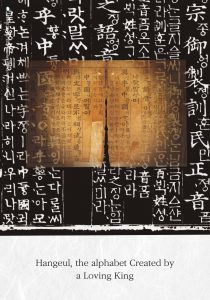 The English and Korean alphabet differs greatly in terms of origin, phonetics, letters, usage, and more. The comparison between the English and Korean alphabet is important because of their remarkable values and global recognition. English remains the most common second language in the world while the Korean alphabet is considered the most scientific writing system of all.
The English and Korean alphabet differs greatly in terms of origin, phonetics, letters, usage, and more. The comparison between the English and Korean alphabet is important because of their remarkable values and global recognition. English remains the most common second language in the world while the Korean alphabet is considered the most scientific writing system of all.
The Korean alphabet, commonly referred to as hang(e)ul, was invented solely by King Sejong in 1443. A detailed manual of how to use this alphabet, including its formation and representation, called Hunminjeongeum(훈민정음), was promulgated three years after the official announcement of hangul’s invention. King Sejong’s work was intended to educate the common people who were unable to read hanja(Chinese characters), which was reserved for elites at the time. There were 28 original letters, consisting of 17 consonants and 11 vowels, while the modern alphabet has 24 letters with 14 consonants and 10 vowels. King Sejong chiefly designed the five basic consonants to represent the visual depiction of the speech organs when each of these consonants are articulated. On the other hand, the three basic vowels are symbolic of the three elements of the universe, Heaven, Man, and Earth. While there were initial controversies regarding the truth of hangul’s invention, it has been proved to be King Sejong’s unique and brilliant creation. Hangul is used today in North and South Korea with notable dialectal differences.
The English alphabet was derived from Latin script and consists of 24 alphabets with five vowels and 19 consonants. English was first written in the Anglo-Saxon futhorc runic alphabet before the old English Latin alphabet was introduced by Christian missionaries in around the 7th century. There is no clear origin or inventor of the English alphabet, and it underwent a series of transformation before reaching the modern orthography. English is grouped into words instead of syllables as in hangul, but both scripts make use of spacing, in which English uses a space in between each word while hangul has specific rules for spacing. The native English script requires no diacritic marks (although they are common in loanwords). Hangul originally contained diacritic marks to indicate the various tones, but they are not used today. Written English also utilizes a variety of digraphs which use a pair of consonant letters to produce a distinct sound, such as ”ch,” ”gh,” ”ng,” and ”wh.” However, both English and hangul have diphthongs, which are a combination of two vowel sounds in the same syllable.
The English and Korean alphabet share a great number of differences and commonalities when we examine their origin, phonetics, letters, and usage. It is important to examine them because both systems have their distinct characteristics that appeal to the mass public, which explain their outstanding status and recognition in the linguistic world.
Written by: Yini Lin.
From Hawaii, United States. University of Hawai’i at Mānoa Class of 2021. B.A. Candidate in Korean Language Flagship. B.A. Candidate in Asian Studies. Exchange student at Korea University. Intern at VANK (Voluntary Agency Network of Korea)